INSTITUT SUPERIEUR D'ANTHROPOLOGIE
INSTITUTE OF ANTHROPOLOGY
ONLINE COURSES / COURS A DISTANCE
FALL TERM : OCTOBER 2013
REGISTER NOW
ROYAUME UNI – 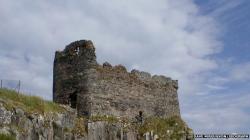
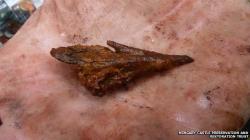 Mingary Castle - An iron arrowhead uncovered during a dig at a ruined castle could be a clue to the site's violent past. Archaeologists and volunteers have been carrying out an excavation at Mingary Castle near Kilchoan, on the Ardnamurchan peninsula. The arrowhead was found by Dave Henderson and later washed and cleaned by Edinburgh-based Addyman Archaeology. Archaeologists said it could be a hunting arrow, but also suggested it may have been used in combat. Mingary Castle dates back to the 13th Century, but the site on which it was built may have first been occupied by the Vikings in earlier times. The site is believed to have close links to Somerled, a 12th Century leader of mixed Norse and Gaelic descent who commanded islands from the Butt of Lewis to the Isle of Man. He secured the territories by leading a fleet of 50 ships into a battle against Godfrey the Black, a Norse king who ruled many of the islands. Mingary, which overlooks the Sound of Mull, was also important to the Lords of the Isles. They ruled islands of the Inner and Outer Hebrides as well as large parts of the west coast of Scotland as a state separate from the rest of the country. The lords included Angus Og Macdonald who waged a civil war against his father John in the 1480s. The rival forces of father and son fought a naval battle at Bloody Bay on Mull. The clan lost half its fleet in the conflict. But archaeologists said the arrowhead could have been used in attacks in later centuries. Ross Cameron of Addyman Archaeology, said: "The arrowhead could easily be in use in the 17th century at the time of the Wars of the Three Kingdoms.
Mingary Castle - An iron arrowhead uncovered during a dig at a ruined castle could be a clue to the site's violent past. Archaeologists and volunteers have been carrying out an excavation at Mingary Castle near Kilchoan, on the Ardnamurchan peninsula. The arrowhead was found by Dave Henderson and later washed and cleaned by Edinburgh-based Addyman Archaeology. Archaeologists said it could be a hunting arrow, but also suggested it may have been used in combat. Mingary Castle dates back to the 13th Century, but the site on which it was built may have first been occupied by the Vikings in earlier times. The site is believed to have close links to Somerled, a 12th Century leader of mixed Norse and Gaelic descent who commanded islands from the Butt of Lewis to the Isle of Man. He secured the territories by leading a fleet of 50 ships into a battle against Godfrey the Black, a Norse king who ruled many of the islands. Mingary, which overlooks the Sound of Mull, was also important to the Lords of the Isles. They ruled islands of the Inner and Outer Hebrides as well as large parts of the west coast of Scotland as a state separate from the rest of the country. The lords included Angus Og Macdonald who waged a civil war against his father John in the 1480s. The rival forces of father and son fought a naval battle at Bloody Bay on Mull. The clan lost half its fleet in the conflict. But archaeologists said the arrowhead could have been used in attacks in later centuries. Ross Cameron of Addyman Archaeology, said: "The arrowhead could easily be in use in the 17th century at the time of the Wars of the Three Kingdoms.
http://www.bbc.co.uk/news/uk-scotland-highlands-islands-23494017
ROYAUME UNI – York - Archaeologists are hoping to piece together a part of York’s history and rediscover a lost medieval church. Archaeology Live! trainees are currently uncovering Victorian buildings and yards as they try to discover the medieval church of St John the Baptist.
http://www.yorkpress.co.uk/news/10573662.Archaeology_Live__trainees_hunt_for_lost_medieval_church/
USA - Gulf of Mexico - Marine archaeologists have discovered a 200-year-old ship along with 60 artifacts three-quarters of a mile below the Gulf of Mexico that may provide some insight into the Texas Revolution. According to the officials from Texas A&M University at Galveston and Texas State University that concluded the recovery Wednesday, the two-masted ship sank 200 years ago. Scientists added that the ship was likely a warship or a vessel transporting arms and soldiers and could have supported the Mexican army during the fight for Texas independence or possibly provided arms to the Texans. The artifacts discovered, which date back to the early 1800s, include muskets, swords, cannons and clothing. A leather-bound book that survived the sinking was also among the items. Researchers said the guns were likely made by the British, but some of the debris is believed to be from Mexico and Spain. "This site has such an amazing rate of preservation that these artifacts are in astoundingly wonderful condition and they truly provide a physical connection with our shared past," said principal investigator Fritz Hanselmann, of the Texas State University Meadows Center for Water and the Environment.
http://www.designntrend.com/articles/6542/20130725/archaeology-news-shipwreck-texas-revolution.htm
TURQUIE – 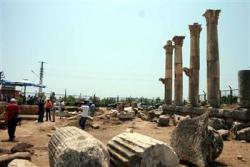 Soli Pompeiopolis - The ancient city of Soli Pompeiopolis in Mersin will have a new archaeopark. Professor Remzi Yagci, who conducted the excavations in the coastal town Soli Pompeiopolis - which dates back 2,000 to 3,000 years - in the Aegean province of Mersin, said they were slanted toward reintegration of the historical area as an archaeopark for international tourism due to great Neolithic, Hellenistic and Roman findings. The archaeologists have started to excavate soil for analysis, starting with the procedure of tagging ceramic pieces, stones and coins. Yagci said the 14th stage of excavation was underway and emphasized their main aim was to reconstruct the ancient Roman city of Soli Pompeiopolis, founded in 65-66 B.C. “We are working on different archaeological areas for new restorations,” said Yagci, adding that the street had an important role for archaeological findings such as Roman shops. He underlined that the African and Phocaea ceramics were reflected in Byzantine social and commercial life. The ancient city of Soli Pompoeipolis, which is located 11 kilometers southwest of Mersin, is a must-see destination. Hosting a variety of civilizations such as pirate colonies, Alexander the Great, the Slevki Empire and Ottoman Empire; Soli Pompeiopolis is a large archaeological site situated in the city center. With the permission of Roman Emperor Julius Caesar, Commander Pompey launched a major expedition against pirates. In his expedition to Mersin’s shores, Pompey destroyed the pirate shelters. However, he showed tolerance to the apologizing pirates and declared Soli as the “city of pardoned pirates.” Since then, the city is known as Pompeiopolis. So far, only 40 of the giant pillars, which were estimated to be 200 originally, have been found. Soli, which is surrounded by large residential areas now, became a busy port during Byzantine times. However, after an earthquake known as “Grand Antakya Earthquake” in 528, which is thought to have been very violent, the city was destroyed to a great extent.
Soli Pompeiopolis - The ancient city of Soli Pompeiopolis in Mersin will have a new archaeopark. Professor Remzi Yagci, who conducted the excavations in the coastal town Soli Pompeiopolis - which dates back 2,000 to 3,000 years - in the Aegean province of Mersin, said they were slanted toward reintegration of the historical area as an archaeopark for international tourism due to great Neolithic, Hellenistic and Roman findings. The archaeologists have started to excavate soil for analysis, starting with the procedure of tagging ceramic pieces, stones and coins. Yagci said the 14th stage of excavation was underway and emphasized their main aim was to reconstruct the ancient Roman city of Soli Pompeiopolis, founded in 65-66 B.C. “We are working on different archaeological areas for new restorations,” said Yagci, adding that the street had an important role for archaeological findings such as Roman shops. He underlined that the African and Phocaea ceramics were reflected in Byzantine social and commercial life. The ancient city of Soli Pompoeipolis, which is located 11 kilometers southwest of Mersin, is a must-see destination. Hosting a variety of civilizations such as pirate colonies, Alexander the Great, the Slevki Empire and Ottoman Empire; Soli Pompeiopolis is a large archaeological site situated in the city center. With the permission of Roman Emperor Julius Caesar, Commander Pompey launched a major expedition against pirates. In his expedition to Mersin’s shores, Pompey destroyed the pirate shelters. However, he showed tolerance to the apologizing pirates and declared Soli as the “city of pardoned pirates.” Since then, the city is known as Pompeiopolis. So far, only 40 of the giant pillars, which were estimated to be 200 originally, have been found. Soli, which is surrounded by large residential areas now, became a busy port during Byzantine times. However, after an earthquake known as “Grand Antakya Earthquake” in 528, which is thought to have been very violent, the city was destroyed to a great extent.
http://www.hurriyetdailynews.com/soli-pompeiopolis-archaeopark-to-open.aspx?pageID=238&nID=51557&NewsCatID=375
ROYAUME UNI –  Eastbourne - An archaeological dig is to take place to uncover the secrets of a 16th Century garden. The Eastbourne Heritage Service is running the community event at Motcombe Gardens in the heart of the Old Town. They are hoping to find out more about the historic dovecote and surrounding area. It is thought to have been constructed in the 1500s when both doves and pigeons were an important source of food.
Eastbourne - An archaeological dig is to take place to uncover the secrets of a 16th Century garden. The Eastbourne Heritage Service is running the community event at Motcombe Gardens in the heart of the Old Town. They are hoping to find out more about the historic dovecote and surrounding area. It is thought to have been constructed in the 1500s when both doves and pigeons were an important source of food.
http://www.theargus.co.uk/news/10574424.Archaeology_dig_aiming_to_uncover_secrets_of_old_garden_in_Eastbourne/
FRANCE – 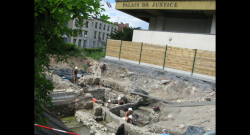
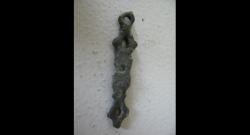 Douai - Les archéologues sont des gens patients. Ils savent attendre leur heure. Souvent, des trésors architecturaux restent emprisonnés du sol parce qu’aucun projet immobilier ou autres ne justifie d’aller creuser là. Ce fut longtemps le cas au pied de la tour du palais de justice, où un parking avait remplacé un îlot de maisons XVIIe, dans les années 70. Il s’est d’abord agi d’investiguer la demi-partie du terrain situé côté Scarpe. Comme l’explique Sébastien Bernez, responsable du chantier, « il a d’abord fallu démolir les restes des caves XVIIIe, qui présentaient peu d’intérêt, pour aller voir ce qui se trouvait dans les niveaux en dessous ». Et les archéologues n’ont pas œuvré en vain puisqu’ils ont notamment mis au jour des pans de murs, mais aussi nombre de pieux en bois, ainsi qu’un reste de four dont on ignore à quoi il pouvait bien servir. Côté objets, la récolte a été plutôt pauvre. Deux toutes petites monnaies en bronze, datant probablement du Moyen Âge (il faudra attendre leur décapage pour en savoir plus), un pendentif du même métal, et un outil en os, utilisé à l’époque par des tisserands pour serrer les rangs de leurs toiles, et c’est à peu près tout. Rien d’étonnant cependant car, ici, on se trouve alors aux limites de la ville, dont le cœur bat plutôt du côté de la place Saint-Amé. Le pont de la Massue – du moins, dans sa version d’alors, le pont de la Laigne (le pont à bois) –, existe déjà. Mais la navigation s’arrête là. Les marchandises arrivant par bateau sont alors déchargées sur les quais. Le bois, côté quai Desbordes et le reste au pied de ce qui deviendra plus tard le parlement de Flandre, puis le palais de justice. Mais qui n’est encore qu’un refuge d’abbaye et un lieu de commerce pour le drap et les céréales. À quoi pouvait bien ressembler l’endroit ? Difficile de le dire. Car le rivage a beaucoup évolué au fil du temps. Tout ce dont on est sûr, c’est qu’il existait déjà ici des parcelles occupées. Comme le prouvent les amoncellements de murs. Les archéologues en ont retrouvé les traces de sept différents, empilés les uns sur les autres. Que soutenaient-ils ? Des entrepôts ? Des habitations ? Voire les deux ? La suite du chantier apportera peut-être des ébauches de réponses.
Douai - Les archéologues sont des gens patients. Ils savent attendre leur heure. Souvent, des trésors architecturaux restent emprisonnés du sol parce qu’aucun projet immobilier ou autres ne justifie d’aller creuser là. Ce fut longtemps le cas au pied de la tour du palais de justice, où un parking avait remplacé un îlot de maisons XVIIe, dans les années 70. Il s’est d’abord agi d’investiguer la demi-partie du terrain situé côté Scarpe. Comme l’explique Sébastien Bernez, responsable du chantier, « il a d’abord fallu démolir les restes des caves XVIIIe, qui présentaient peu d’intérêt, pour aller voir ce qui se trouvait dans les niveaux en dessous ». Et les archéologues n’ont pas œuvré en vain puisqu’ils ont notamment mis au jour des pans de murs, mais aussi nombre de pieux en bois, ainsi qu’un reste de four dont on ignore à quoi il pouvait bien servir. Côté objets, la récolte a été plutôt pauvre. Deux toutes petites monnaies en bronze, datant probablement du Moyen Âge (il faudra attendre leur décapage pour en savoir plus), un pendentif du même métal, et un outil en os, utilisé à l’époque par des tisserands pour serrer les rangs de leurs toiles, et c’est à peu près tout. Rien d’étonnant cependant car, ici, on se trouve alors aux limites de la ville, dont le cœur bat plutôt du côté de la place Saint-Amé. Le pont de la Massue – du moins, dans sa version d’alors, le pont de la Laigne (le pont à bois) –, existe déjà. Mais la navigation s’arrête là. Les marchandises arrivant par bateau sont alors déchargées sur les quais. Le bois, côté quai Desbordes et le reste au pied de ce qui deviendra plus tard le parlement de Flandre, puis le palais de justice. Mais qui n’est encore qu’un refuge d’abbaye et un lieu de commerce pour le drap et les céréales. À quoi pouvait bien ressembler l’endroit ? Difficile de le dire. Car le rivage a beaucoup évolué au fil du temps. Tout ce dont on est sûr, c’est qu’il existait déjà ici des parcelles occupées. Comme le prouvent les amoncellements de murs. Les archéologues en ont retrouvé les traces de sept différents, empilés les uns sur les autres. Que soutenaient-ils ? Des entrepôts ? Des habitations ? Voire les deux ? La suite du chantier apportera peut-être des ébauches de réponses.
http://www.lavoixdunord.fr/region/quand-le-douai-du-moyen-age-resurgit-lors-de-fouilles-au-ia16b12100n1441733